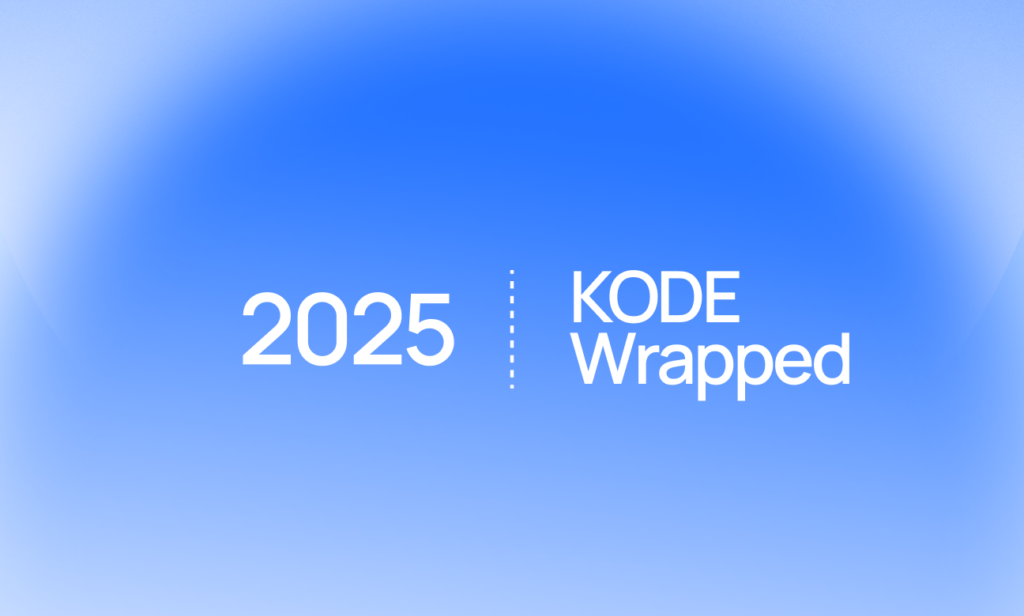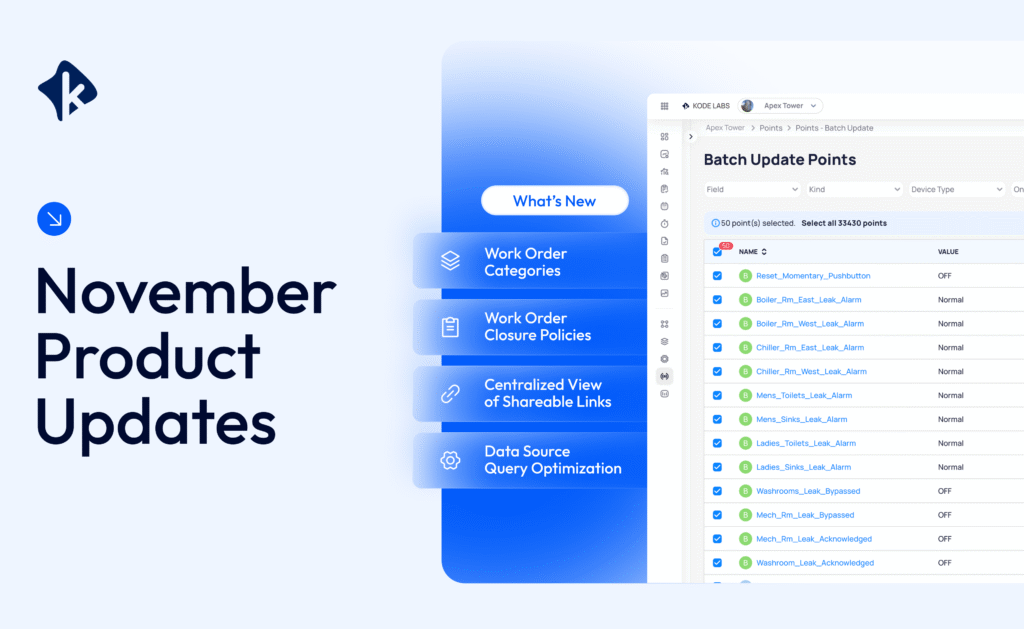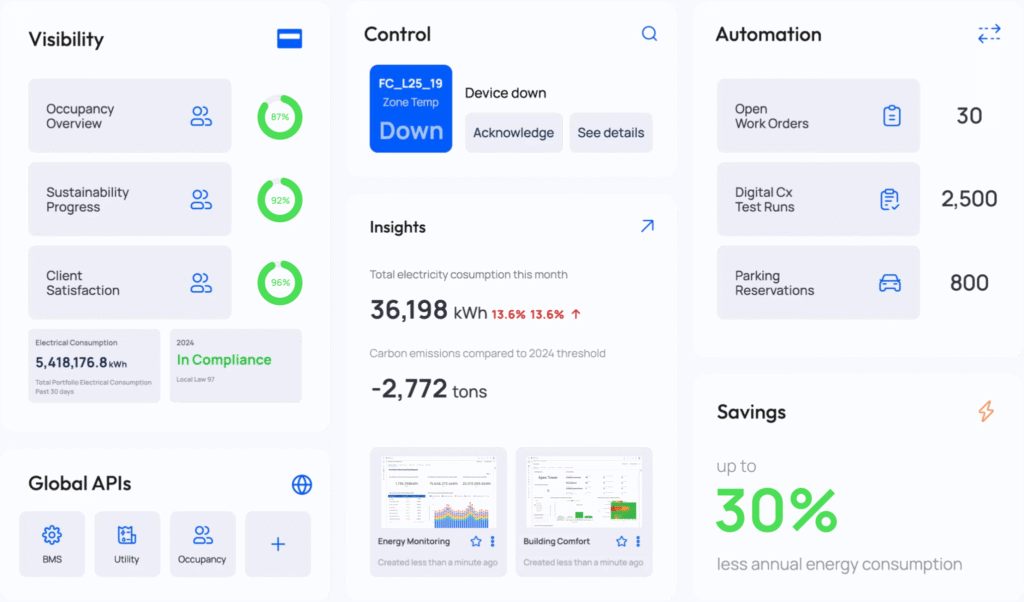By KODE Team
On this page
Sign up to our newsletter
Subscribe to receive the latest blog posts to your inbox every week.
By subscribing you agree to with our Privacy Policy.
In today’s real estate landscape, sustainability isn’t just a value, it’s an expectation. Whether driven by internal ESG commitments, regulatory mandates, or stakeholder scrutiny, organizations are being asked to show their work. That means turning fragmented building data into structured, auditable reporting.
This article walks through how KODE OS simplifies these processes, from data ingestion to disclosure, helping Sustainability teams and Executives stay both compliant and confident.
The Challenge: ESG Reporting is a Data Problem
For sustainability teams and C-level executives alike, ESG disclosure can feel overwhelming. Key metrics like energy usage, emissions, occupancy, and cost are often scattered across utility providers, legacy BMS systems, spreadsheets, and third-party software/auditors. Data quality issues including missing records, duplicates, uncalibrated meters, and more, create delays and risk inaccuracies. And with increasing scrutiny from stakeholders and regulators, there’s little room for error.
Most real estate portfolios suffer from:
- Disparate data sources: BMS, utility bills, submeters, IAQ sensors, and occupancy sensors that don’t talk to each other.
- Low data quality: Gaps, duplicate records, unnormalized units, and unstructured formats (PDFs, CSVs, scanned statements).
- Manual effort: Spreadsheets patched together quarterly, often by already stretched teams.
- Lack of auditability: Difficulty tracing reported metrics back to source data with full transparency.
This complexity makes it difficult to align with frameworks like GRESB, CDP, or regulatory mandates like LL97 or CSRD.
KODE OS: From Raw Data to Reporting Ready
KODE OS, through its EnerG module and its features, addresses these challenges head on. It transforms fragmented building and utility data into structured, real-time insights. Automated, auditable, and aligned to your sustainability goals.
Here’s how it works:
Automated Data Ingestion
KODE OS connects to over 170 data sources, from building automation systems, IoT devices, utility providers, interval meters, third party platforms and more.
The result = consistent collection of:
- Energy use and costs (by fuel type, by space, by device, etc.)
- Water and waste data
- Scope 1, 2, and 3 emissions
- Occupancy and utilization data
All ingestion is automated, but also flexible enough to support manual uploads when needed, such as historical data, one-off statements, or input from systems without API access.
Data Normalization & Cleansing
Before any analytics or reporting begins, data quality is ensured. KODE OS applies:
- Calendarization to match usage to actual consumption periods
- Unit conversions to standardize metrics
- Weather normalization for accurate YoY comparisons
- Gap-filling and spike detection to correct anomalies
- Metadata layering (e.g., tenant name, suite location, equipment) for detailed granularity
- Connected asset records to eliminate data siloes by linking asset information from different sources
This isn’t just cleanup, it’s foundational to accurate reporting and robust measurement & verification (M&V).
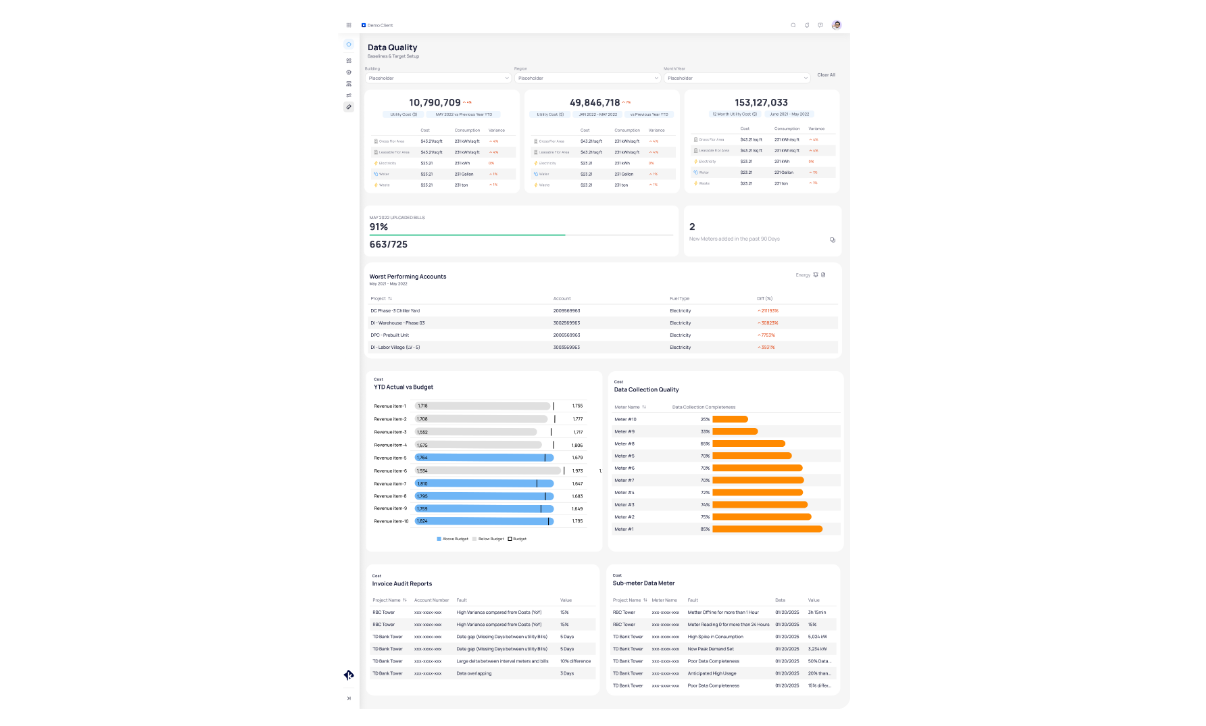
Performance and ESG Metrics at Your Fingertips
Once your data is centralized and validated, KODE OS enables you to track, analyze, and disclose performance with confidence.
Built-in KPIs and ESG Framework Alignment
KODE OS includes pre-configured KPIs such as:
- Rolling Energy and Water Use Intensity (EUI/WUI)
- Scope 1, 2, and 3 emissions
- Weather-adjusted consumption and carbon trends
- Actual vs. budget or target metrics
- Demand and peak load analysis
These are tailored to align with leading reporting standards and can be broken down by building, meter, tenant, or portfolio level.
Custom Dashboards and Reports
Within KODE OS, teams can generate:
- Monthly, quarterly, and annual usage reports
- Cost and emissions summaries
- Actual vs. billed/target performance
- Forecasts based on historical consumption and seasonality
Data can be sliced, visualized, and exported for direct input into CDP, GRESB, or internal sustainability reports.
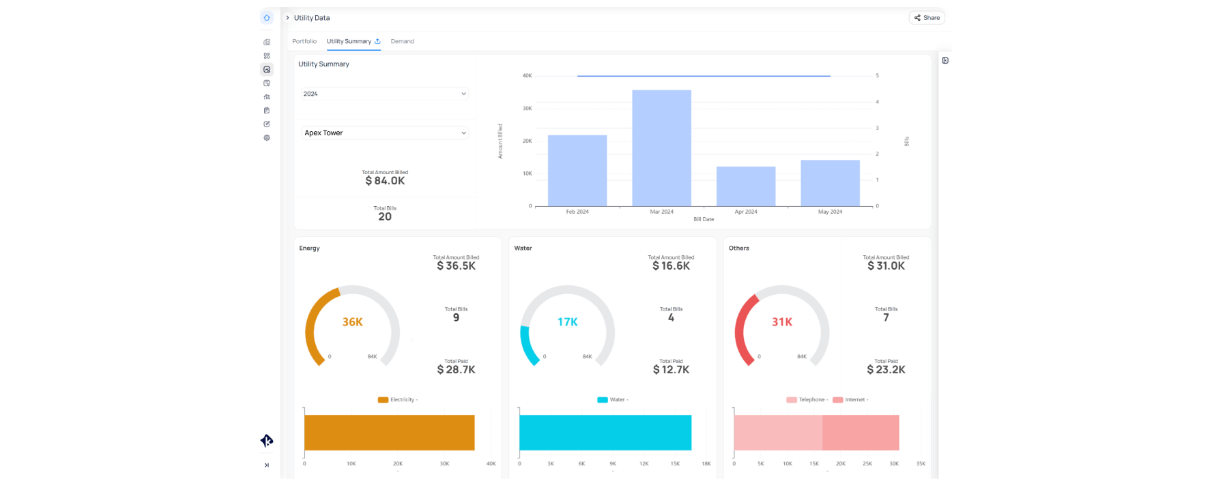
Planning and Forecasting Carbon Reductions
Sustainability is not just about tracking the past, it’s about planning the future. The Decarbonization module further supports capital planning by linking building audits to forecasted improvements in emissions and energy savings, essential for setting and tracking net-zero strategies.
Scenario Building for Capital Improvements
Utilizing ASHRAE Level 1 audit data or your own Energy Conservation Measures (ECMs), the platform enables:
- Development of multiple investment scenarios
- Prioritization based on carbon reduction, cost savings, or payback period
- Forecasting of emissions and consumption reductions over time
- Modeling of compliance with local or national mandates (LL97)
Portfolio Level Strategy
Aggregated views allow sustainability teams and executives to:
- Monitor net-zero progress across multiple sites
- Evaluate tradeoffs between cost, timeline, and emissions
- Compare strategies side-by-side for optimal and informed decision-making
Whether you’re evaluating retrofit ROI or mapping out a carbon budget, the Decarb module brings clarity to complex capital planning.
Own Your ESG Narrative with Verified Data
One of the greatest advantages KODE OS brings to sustainability teams is credibility. In a landscape where ESG claims are under increasing scrutiny, the ability to back every figure with verified, real-time data becomes a strategic differentiator.
KODE OS ensure your reporting is:
- Traceable: Full audit trails from high-level reports down to the original source data.
- Consistent: Standardized metrics across all buildings, utilities, and reporting periods.
- Current: Real-time data, not weeks or months old estimates.
With KODE OS, your ESG reports move beyond regulatory checkboxes. They become a powerful reflection of your progress, priorities, and performance. It’s the confidence you need to communicate your impact to stakeholders, investors, and the public.
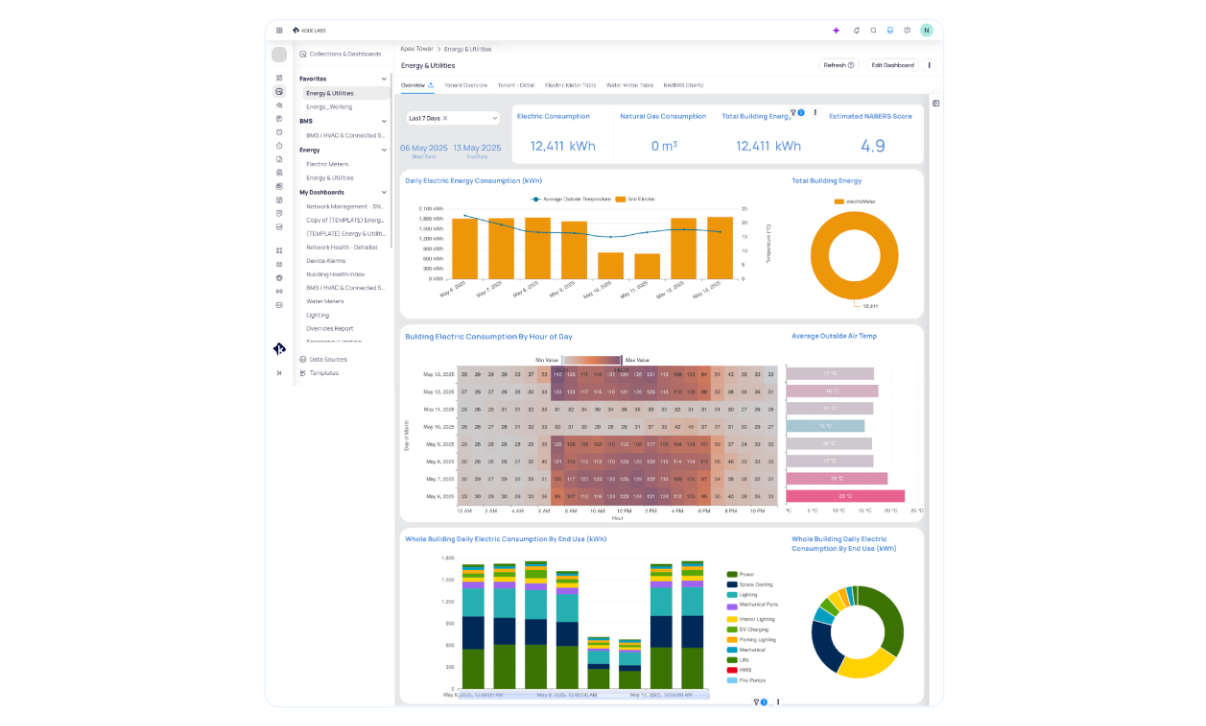
Beyond Compliance: Operational Value
While ESG compliance is a highly important goal, the insights provided by KODE OS also help deliver real world performance improvements by:
- Identifying buildings with energy drift or high carbon intensity
- Flagging abnormal consumption patterns down to specific devices
- Pinpointing opportunities for schedule adjustments and equipment upgrades
- Breaking down usage and costs by floor, zone, or department to support internal benchmarking and budget tracking.
KODE OS enables cross functional alignment between Sustainability, Operations, and Finance, all working from a single source of truth.
Turning Data into Action: From Reporting Burden to Strategic Value
Collecting data is one thing, doing something meaningful with it is another. Too often, sustainability teams are stuck managing fragmented systems and chasing down numbers that should already be at their fingertips.
KODE OS brings it all together, turning raw data into structured insights, and reporting into a process you can rely on. With everything in one place, you get the clarity to track progress, the tools to take action, and the confidence to report it.
Ready to experience how EnerG and KODE OS would impact your organization? Reach out to our team today.
______________________________________________________________
About EnerG
EnerG is KODE’s upcoming solution designed to make utility data more accessible, manageable, and actionable. It automates utility data collection and consolidates it into a single source of truth. EnerG is built to support your journey to net zero by streamlining critical workflows, identifying reduction opportunities, and tracking progress with confidence.

